Last updated on July 8, 2025
MFA for WatchGuard Firebox is an added security measure that requires users to provide extra proof of identity to connect to the Firebox. Alongside the standard login/password primary authentication, WatchGuard Firebox introduces a secondary authentication that the user must complete. This secondary authentication involves the user approving a Mobile Push authentication request sent to their mobile device. Only upon completion of both primary and secondary authentication can the user access the firewall. Thus, even if cybercriminals have your password, MFA for WatchGuard Firebox prevents them from connecting to the firewall.
Overview
Rublon Multi-Factor Authentication for WatchGuard Firebox enables you to enhance the security of your WatchGuard Firebox logins. MFA for WatchGuard Firebox is implemented using the Rublon Authentication Proxy.
Rublon MFA for WatchGuard Firebox facilitates Multi-Factor Authentication (MFA) / Two-Factor Authentication (2FA) during WatchGuard logins to the Firebox firewall. If a user correctly enters their username and password, they will be asked to complete an additional authentication method. If the user is unable to complete the secondary authentication, Rublon will deny access, thereby thwarting a potential hacker’s attempt to gain entry.
Supported Authentication Methods
| Authentication Method | Supported | Comments |
| Mobile Push | ✔ | N/A |
| WebAuthn/U2F Security Key | – | N/A |
| Passcode | ✔ | N/A |
| SMS Passcode | – | N/A |
| SMS Link | ✔ | N/A |
| Phone Call | ✔ | N/A |
| QR Code | – | N/A |
| Email Link | ✔ | N/A |
| YubiKey OTP Security Key | ✔ | N/A |
Before You Start Configuring MFA for Watchguard Firebox
Before configuring Rublon MFA for WatchGuard Firebox:
- Ensure you have prepared all required components.
- Create an application in the Rublon Admin Console.
- Install the Rublon Authenticator mobile app.
Required Components
1. User Identity Provider (IdP) – You need an external Identity Provider, such as Microsoft Active Directory, OpenLDAP, or FreeRADIUS.
2. Rublon Authentication Proxy – Install the Rublon Authentication Proxy if you have not already.
3. WatchGuard Mobile VPN – Ensure you have correctly configured your WatchGuard Firebox Cloud (PAYG) with Mobile VPN, especially that user logins work properly before deploying MFA for WatchGuard.
Create an Application in the Rublon Admin Console
1. Sign up for the Rublon Admin Console. Here’s how.
2. In the Rublon Admin Console, go to the Applications tab and click Add Application.
3. Enter a name for your application (e.g., WatchGuard Firebox) and then set the type to Rublon Authentication Proxy.
4. Click Save to add the new application in the Rublon Admin Console.
5. Copy and save the values of the System Token and Secret Key. You are going to need these values later.
Install Rublon Authenticator
Some end-users may install the Rublon Authenticator mobile app. So, as a person configuring MFA for WatchGuard Mobile VPN, we highly recommend you install the Rublon Authenticator mobile app, too. Thanks to that, you will be able to test MFA for WatchGuard via Mobile Push.
Download the Rublon Authenticator for:
Configuring Multi-Factor Authentication (MFA) for WatchGuard Firebox
Follow the following instructions to set up MFA for WatchGuard Firebox.
1. Log in to the WatchGuard Firebox Admin Panel (Fireware Web UI).
2. In the left pane, click Authentication and then select Servers.
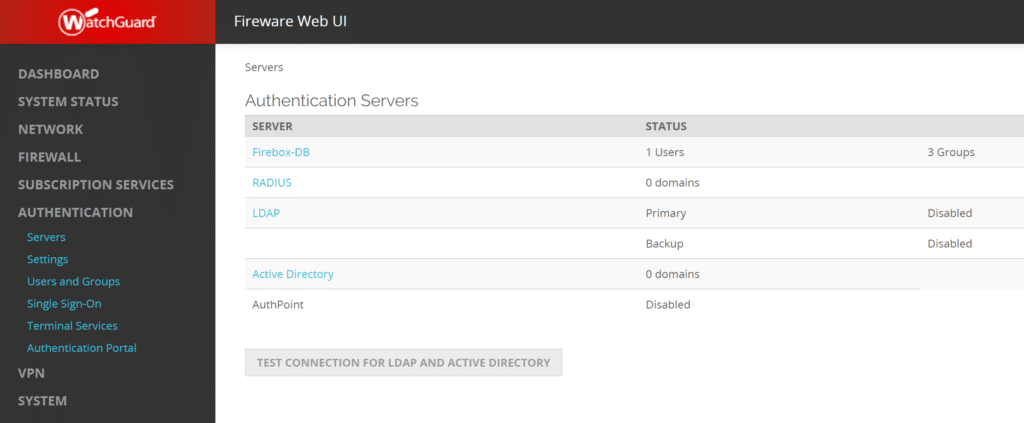
3. Click Active Directory.
4. Click the lock to make changes and then click ADD.
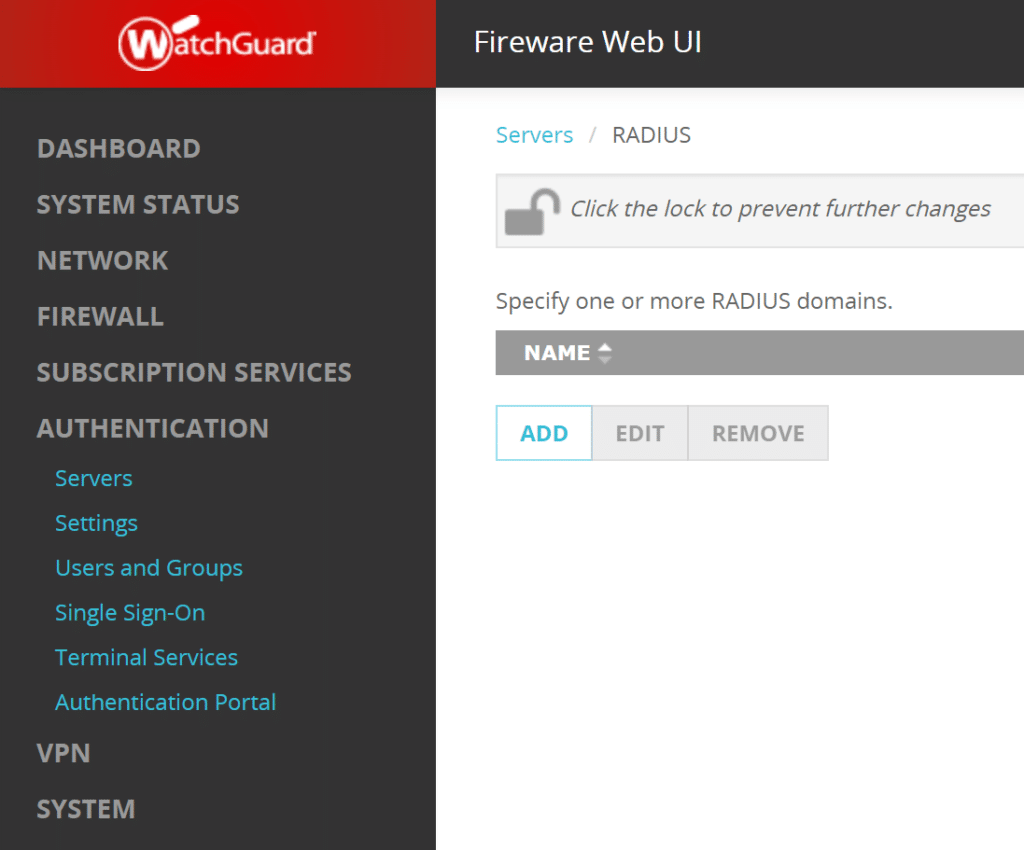
5. Fill in the form. Refer to the following image and table.

| Domain Name or IP Address | Enter the IP address of the Rublon Authentication Proxy. |
| Port | Enter the port of your Rublon Authentication Proxy server. Default: 1812 |
| Timeout | 60 If experiencing issues, increase to 90. |
| Dead Time | 10 (Minutes) |
| Search Base | Enter the Base DN of a user who has Read rights in your Active Directory server. |
| Group String | tokenGroups |
| Login Attribute | cn |
| DN of Searching User | Enter the Bind DN of a user who has Read rights in your Active Directory server. |
| Password of Searching User | Enter the password of the user defined by Bind DN. |
6. Click SAVE to save your changes.
7. The Active Directory server you added should now be visible in the list of servers.
Configuring Mobile VPN
1. In the WatchGuard Firebox Admin Panel, click VPN and then select Mobile VPN.
2. Make sure the padlock is open. If it is closed, click it to open it. Otherwise, you will not be able to make any changes.
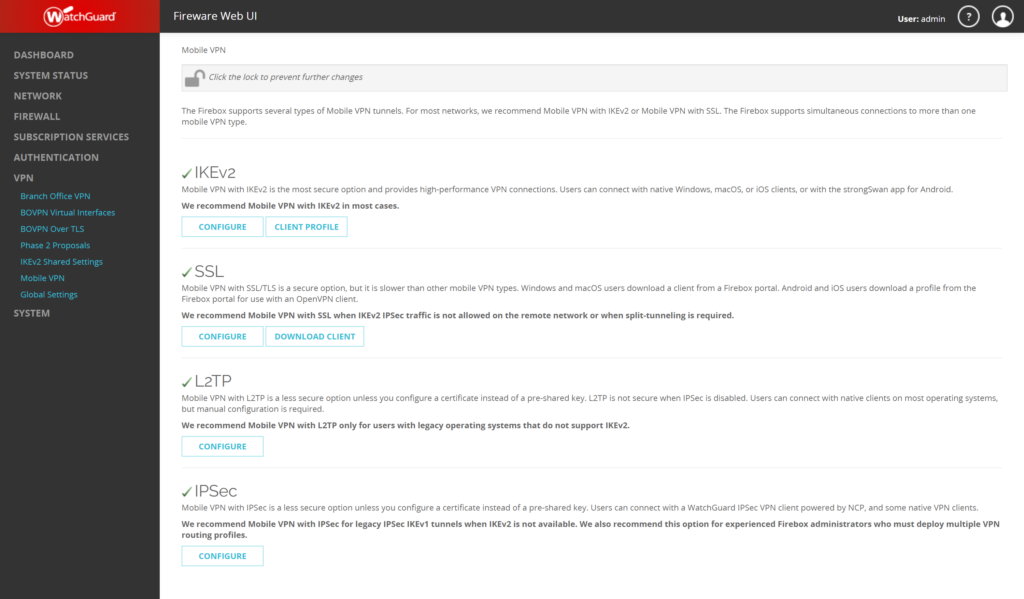
Mobile VPN Configuration with IPSec
1. In Mobile VPN, navigate to the IPSec section and click CONFIGURE.
2. In the Groups section, select your profile and click EDIT.
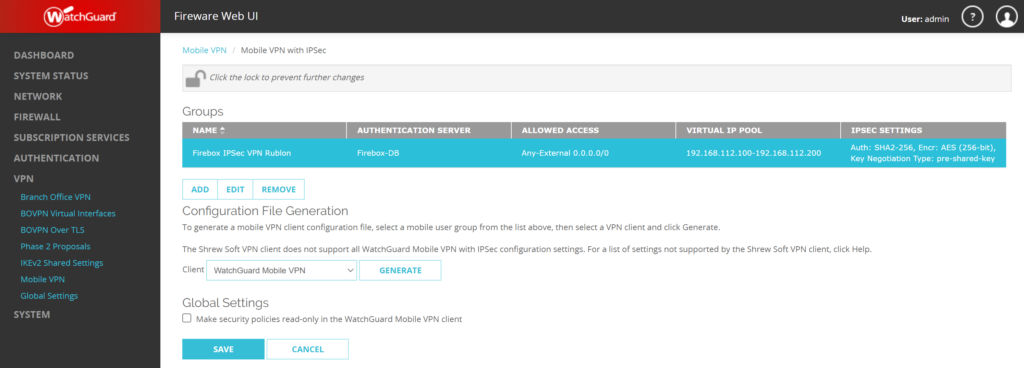
3. Select the General tab.
4. In the Authentication Server dropdown, select your Rublon Authentication Proxy server. It has the Domain Name you set when configuring Rublon Authentication Proxy as Active Directory server.

5. Click SAVE to save your changes.
Mobile VPN Configuration with SSL
To make MFA for SSL Mobile VPN work, you have to manually add all your users to WatchGuard VPN and then allow them to use SSL VPN. Let’s do it:
1. In the left pane, expand Authentication and select Users and Groups. Then, click ADD to add a new user.
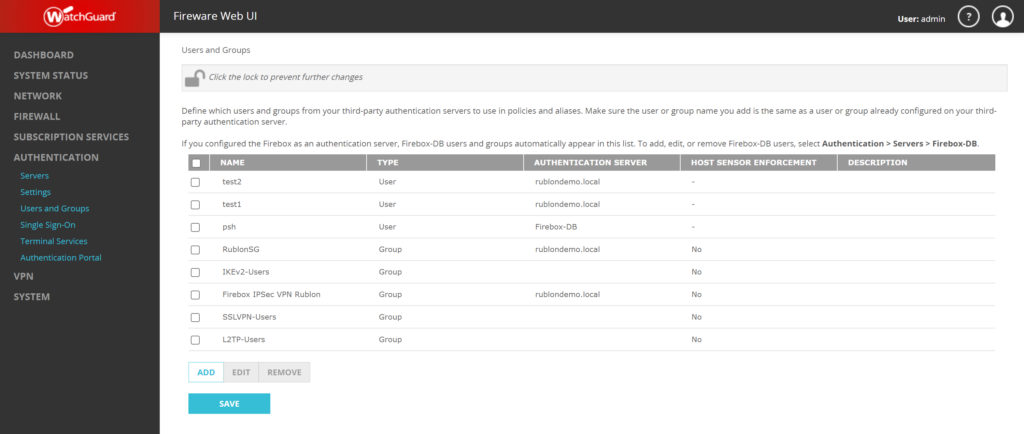
2. In Add User or Group, enter the name of the user and select the authentication source.

| Type | User |
| Name | Enter the username. |
| Description | This is optional, but you can enter a description of the user if you want. |
| Authentication Server | Select the Rublon Authentication Proxy server you have created before. |
3. Other options are optional. Click OK and then click Save in the main list of all groups and users to confirm the new user.
You need to do the above three steps for all users you want to allow to use Mobile VPN with SSL.
4. After you added all your users, you can configure SSL VPN. In the left pane, click VPN and select Mobile VPN. Then, navigate to the SSL section and click CONFIGURE.
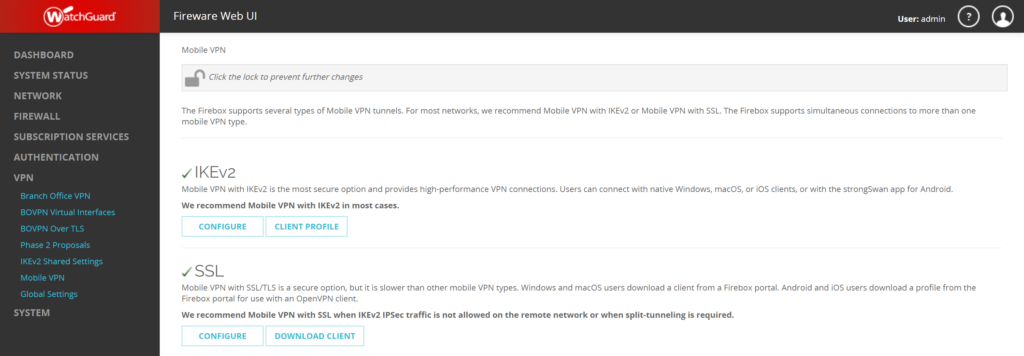
5. Select the Authentication tab.
6. In AUTHENTICATION SERVERS, select your Rublon Authentication Proxy server and click ADD. Then, select it on the list of authentication servers and click MOVE UP to make it default.
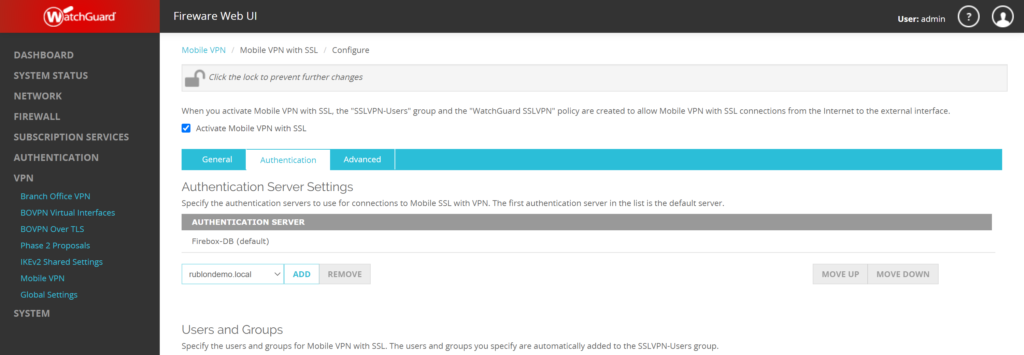
7. In Users and Groups, select the groups and users you want to allow to use SSL VPN.
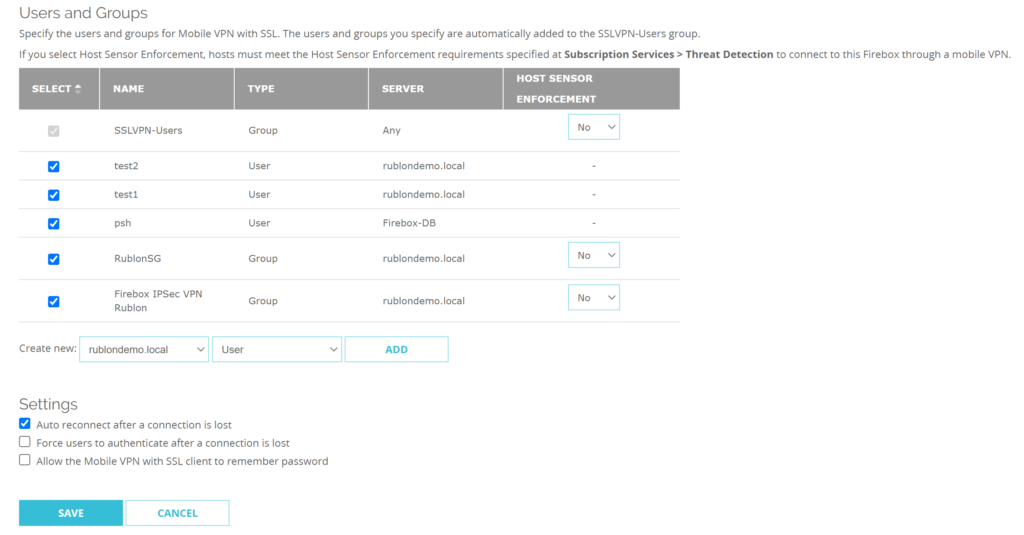
8. Click SAVE to confirm and save the changes you made.
Testing Multi-Factor Authentication (MFA) for WatchGuard Mobile VPN (IPSec)
In this WatchGuard Mobile IPSec VPN testing example, we used the WatchGuard Mobile VPN application (Mobile VPN Monitor). The first time you run WatchGuard Mobile VPN, you have the opportunity to create a VPN profile. When creating the VPN profile, you can import the configuration file generated in Mobile VPN.
After importing a connection profile, test the connection:
1. Open the WatchGuard Mobile VPN client and click the red Connection button.

2. Enter your User ID and password and click OK.

3. Rublon will send a Mobile Push authentication request to your phone. Tap APPROVE.
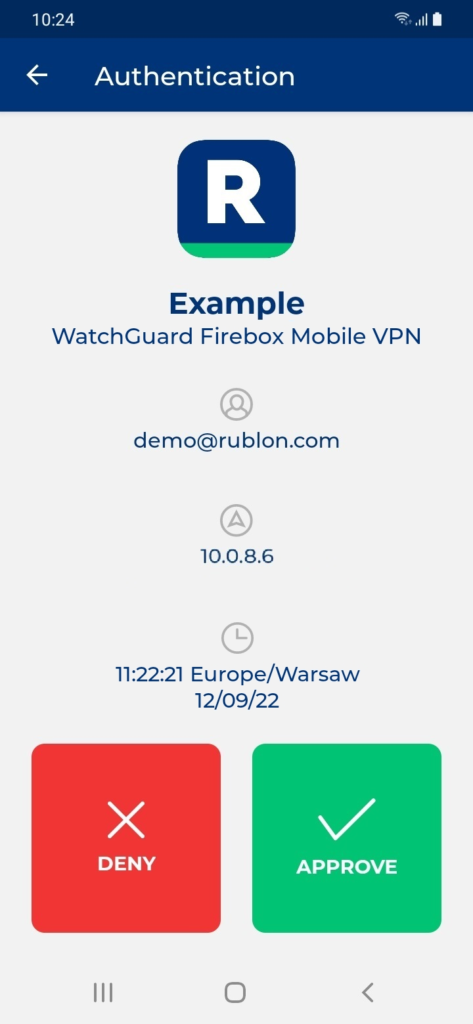
4. You will connect to the VPN.

Testing Multi-Factor Authentication (MFA) for WatchGuard Mobile VPN (SSL)
In this WatchGuard Mobile SSL VPN testing example, we used the WatchGuard Mobile VPN with SSL client.
1. Provide the IP of your server, the user name and password, and click Connect.

2. Rublon will send a Mobile Push authentication request to your phone. Tap APPROVE.

3. After approving the push, the window will minimize, and you will see a notification informing you that a connection was made.
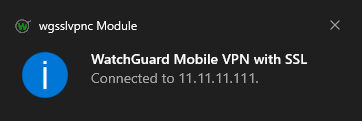
Troubleshooting
If you encounter any issues with your Rublon integration, please contact Rublon Support.